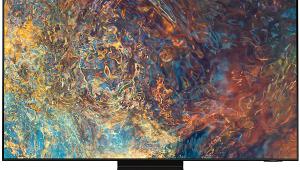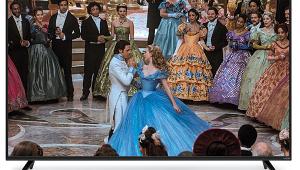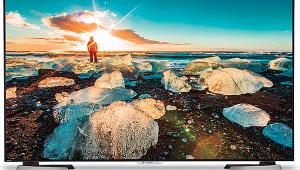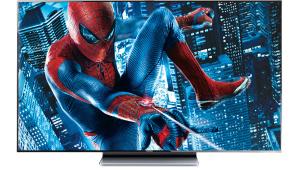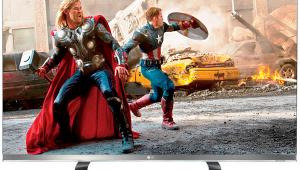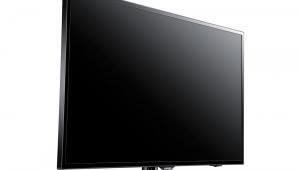Sharp LC-37D40U LCD HDTV Television

The flat form factor may be in, but flat panels are not necessarily superior in all respects. CRTs still do some things better than any current digital display technology. But CRTs aren't as sharp or bright as flat panels, and they're big and heavy. Flat panel LCD and plasma designs also realize the decades-old dream of a TV you can hang on the wall, out of the way—never mind that many buyers put their flat panel sets on stands! And one advantage that LCDs have over plasmas is that the latter are generally limited to sizes of 37" (diagonal) or larger. Plasma technology has, up to now, mandated larger panel sizes because the pixels could not be reduced enough in size for smaller screens.
Sharp has been a class leader in this LCD revolution, manufacturing models in a range of sizes to fit any niche—in every sense of that term.
Flat is In
At 37" diagonal, the Sharp LC-37D40U ($2,599.99) falls in the upper echelon of relatively affordable LCD sizes, which generally extends up to about 45". Sharp does offer models up to 65", but so far the prices for such huge models are in the "if you have to ask" range.
Sharp does engage in a common bit of specmanship with this set in specifying it as having "3,147,264" dots, or pixels. The native resolution of the set is actually 1366x768. There are three separate LCD elements that make up each visible pixel, one for each of the primary colors, red, green, and blue. But the three overlap—a requirement for each pixel to reproduce the full color gamut. So the number of pixels on the screen that actually make up the resolution of the image you see is 1366x768, or 1,049,088 pixels—a resolution common to many high-definition LCD displays—not the 3,147,264 touted in the sales literature. This is a full-featured television, offering both standard and high-definition over-the-air tuners (but no CableCARD). A single antenna hookup and rapid, automatic antenna/cable channel search mode makes setting up the set's tuners a breeze. Users who receive programming both from an antenna and unscrambled cable might miss the convenience of separate antenna and cable RF inputs. But for most consumers the single antenna input does greatly simplify hookup.
There are also plenty of additional inputs for other sources. While the set does not offer direct selection of these inputs, unused ones are automatically skipped over as you go "around the horn" to select the one you want. You can also rename the inputs so you don't have to remember what's connected where.
Most of the set's other controls are those you normally find in high-end sets, with a few notable differences. In addition to the usual Contrast, Brightness, Color, Tint, and Sharpness controls, there is also a Backlight control, which adjusts the level of—you guessed it—the backlight. Nearly all current flat panel LCDs use a fluorescent backlight as a light source, in contrast to plasmas, with which self-illumination is inherent in the technology. The Backlight control raises and lowers the level of the backlight, and thus the overall illumination of the image. While you might think this would be a good way to improve the black levels of an LCD, in practice I found that a setting within two or three steps of the midpoint (the STD setting) worked best in the darkened room I used for most of my evaluation.
But another feature, called OPC, can be engaged to automatically adjust the backlight level depending on the amount of light in the room. It did work—the increase in light output was visible when the room light was switched on—but I left it off for most of my viewing.
There are also several Advanced picture adjustments. The Color Temperature control offered five different settings. I did not perform a service-level calibration on the Sharp (explained in the "Testing and Calibration" section). One reason for this was the fact that the Mid-Low setting of the color temperature control was quite accurate using HDMI, though a bit less so with component video.
The Black control slightly darkens the image. The effect was relatively subtle when I tried it, so I left it off. 3D-YC is a comb filter that is relevant only with composite analog sources. Monochrome is for black and white images, which I didn't watch with the exception of a few minutes of the opening of The Phantom of the Opera on HD DVD. This looked fine without resorting to the Monochrome control. Film Mode (On/Off) is just what you might expect it to be- a 3/2 pulldown mode for film sources. And a "Range of OPC" adjustment controls the sensitivity of the OPC sensor.
One quibble: The adjustment menus do not drop away or minimize when changes to the settings are being performed, which often made it difficult to see the test pattern or source I was trying to view while making the adjustment.
There are also several AV modes, with the usual cryptic names: Standard, Movie, Game, User, Dynamic (Fixed) and Dynamic. All of these may be separately adjusted by the user, except Dynamic (Fixed). While you can't set up the video adjustments separately for each input, you can use a different adjustable mode for each input, which effectively provides the same capability.
There are also four selectable aspect ratios (Sharp calls this "View Mode"). For standard definition resolutions you get Side Bar (unmodified 4:3 on the wide screen with black side bars), Smart Stretch (one of those stretchy modes for filling the 16:9 screen with a 4:3 image), Zoom (for letterbox widescreen sources, incorrectly described in the manual as suitable for anamorphic 2.35 DVDs), and Stretch (for anamorphic sources). With 720p and 1080i sources the set is locked into the Stretch mode.
The remote can control several products and is also illuminated (though not all the control labels are backlit). It's a good one, sculpted to handle easily, with well-spaced buttons of different shapes and sizes. Only the flip-open compartment at the bottom seems quirky, since it conceals a scant five buttons.
The onboard audio system offers the usual array of features. You'll want to use an outboard audio system for serious listening, however, as there just isn't enough space inside these thin panels for the sort of full-bodied sound that regular visitors to this site, I hope, want for movies and other high quality programming. The Sharp's digital output does let you pass the audio from the on-board tuners to an outboard receiver or pre-pro for decoding the audio format in the source, including 5.1-channel Dolby Digital.
Black on Black
Features are always welcome, but they don't mean much unless the picture measures up. While the Sharp LC-37D40U comes up short in one area, that particular shortcoming is common, so far, to LCD displays. Let's get it out of the way first. Flat panel LCD manufacturers are still working to improve the blacks and contrast ratios of their products, and have made significant progress. But they aren't quite there yet. The Sharp's blacks are medium to dark gray, not black.
What are the visible consequences of this? On the darkest scenes, the picture looks murky and ill-defined as a gray fog settles over the image.
I am talking about very dark scenes here, of the sort generally found only in movies and some filmed television dramas. But many dark scenes have bright highlights to ensure that the audience can follow the action, and here digital displays, including this Sharp, do far better. On such material—and on some lighter scenes as well—the eye can sometimes see this slight gray haze in the image, but it's possible to adjust to it, and over time it will rarely be a distraction. But in those really dark scenes it is. Many viewers apparently aren't bothered by this, perhaps because it's less obvious in a well-lit room. Most viewers are also less critical of gray blacks because they are accustomed to too-light blacks in their own, poorly adjusted displays.
On the Screen
There, I've gotten that off my chest. Having clearly stated that one caveat, the Sharp produces an otherwise remarkably pleasing picture. Once I get away from the darkest scenes, and in particular move on to the brighter images that dominate most sports, TV programs, and many films, I was very impressed by what I saw.
The Sharp produces a remarkably crisp, three-dimensional image. Even on standard definition DVDs it's impressive. I could easily see the difference between the sharpest DVDs, like Gladiator and slightly softer ones, like the otherwise superb Munich. But given proper adjustment of the Sharpness control, the image never looked overly enhanced or artificially etched.
And pop on something like The Phantom of the Opera, one of the best-looking HD DVDs, and watch either the opening rehearsal sequence or the masquerade ball scene. Here, the Sharp's jaw-dropping factor is limited only by the relatively small size of its screen.
The size of that screen does restrict the ability of the eye to resolve the very finest detail. For example, on a reasonably large screen, a good projector will actually resolve the smallest lettering in the FBI seal that opens most HD DVDs. But I could not read it on the Sharp from my approximately 8-foot viewing distance. But even though the lettering is simply too small for my eyes to resolve from that distance on a 37" screen, the subjective detail of the Sharp on the best program material is superb.
Criticisms of the color palette of LCD displays isn't hard to come by, but once it's properly set up I'll stack the color of the Sharp up against any digital display. Flesh tones were spot on and always natural-looking. Brightly lit green foliage looked right for a change—digital displays too often give it a bright, artificial "Crayola" glow. Most of the time the Sharp's greens didn't distract me at all—which isn't faint praise. Yes, there were exceptions, but they appeared to originate in the source. The outdoor classroom flashback scenes on the Serenity HD DVD had that bright, "fresh" green look. But the opening scenes in Charlotte Gray on DVD, as the train winds through the lush French landscape, the greens looked right on the Sharp. On most digital displays, they don't.
The eye is most critical of things it sees in real life every day, so once flesh tones and green foliage look right, everything else falls into place. But I only arrived at this happy state by dramatically dialing back the Color control. Component video required more correction than HDMI. In fact, for the best result I actually had to add in a couple of steps on the color saturation control in the Pioneer Elite DV-79AVi DVD player to dial back the color even beyond the maximum usable setting of -29 in the Sharp (-30 turns the color off completely).
